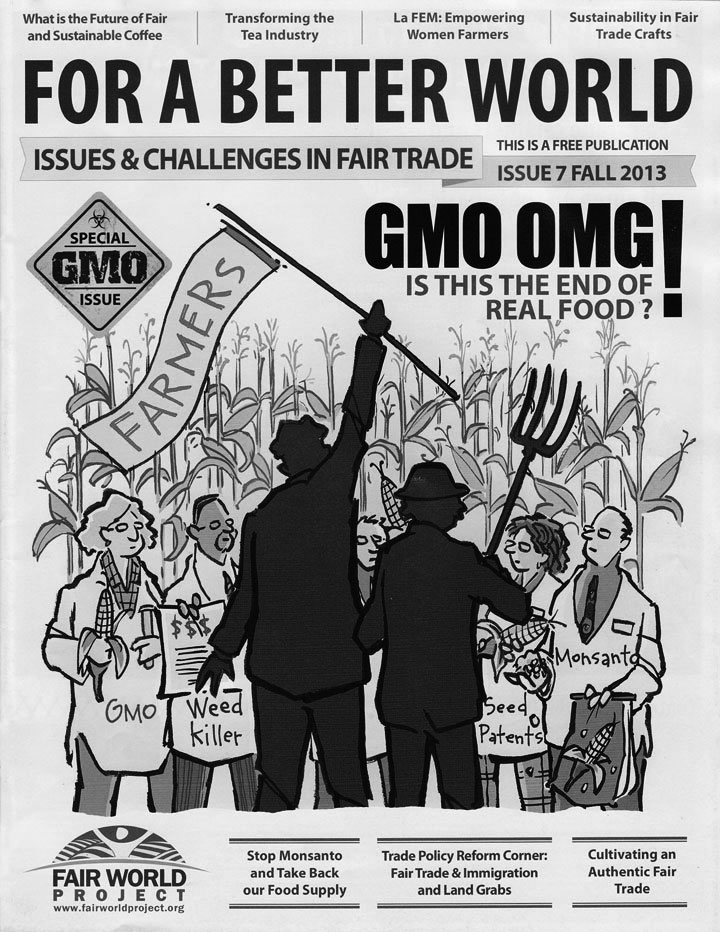Wherever he lived, John Steinbeck kept a garden. He believed that being close to nature and living in harmony with the earth’s ecology was an essential part of being human. What I learned about industrial agriculture on my recent trip through Steinbeck Country would make the author of The Grapes of Wrath spin in his grave.
How My Genetically Modified Food Education Began
Steinbeck—not genetically modified food—was on my mind when we set out for King City, Paso Robles, and San Luis Obispo—our ultimate destination—recently. There, on busy Monterey Street, a used bookstore beckoned with roomfuls of books on every imaginable subject. In the fiction area, high above the ‘S’ authors, hung huge photos of John Steinbeck and Ed Ricketts. A good sign! On the shelf below, between Gertrude Stein and Thomas Steinbeck—nothing. As the store’s manager explained, San Luis Obispo is an ecology-minded, Steinbeck-loving college town. Used copies of anything by Steinbeck are snapped up quickly. An even better sign for our Steinbeck Country weekend!
Monsanto, EPA, FDA, and Global GMO Food Disaster
The store next door had an intriguing name: HumanKind Fair Trade. A handwritten sign by the door described the inventory and promoted the virtues of purchasing Fair Trade certified products. Inside, among colorful fabrics and hand-woven garments, a stack of For A Better World magazines caught my attention. With nothing by Steinbeck to occupy the rest of the trip, I decided to take a copy of the magazine’s special GMO (Genetically Modified Organisms) issues for bedtime reading. I didn’t sleep well. I kept thinking about the helicopters overhead on Highway 101 as we made our way south through the lettuce fields surrounding Soledad, Greenfield, and King City. They were spraying pesticides.
How Monsanto, the EPA, and the FDA Collude to Control
At home I watch the news and keep up with current events. I’d heard about the controversy over genetically modified food crops and genetically modified farm animals. But until I read my copy of For A Better World that night in San Luis Obispo, I had no idea that industrial agriculture and Monsanto have colluded successfully to control the world food supply with EPA, FDA, and USDA approval. I began to wonder why the terrifying genetically modified food story isn’t on the news every night. This GMO monster is a menace to global survival, and the battle against Monsanto may be the most important call to action the world faces today. So why are so-called consumer-protection agencies like the EPA, FDA, and USDA staying on the sidelines?
EPA + FDA + USDA = Former Monsanto Executives, Monsanto Lobbyists, and Monsanto Board Members
Over the past 10 years, seven or more former Monsanto employees have held high-level positions at the FDA. Michael R. Taylor, currently the Deputy Commissioner of the FDA’s Office of Foods, was also Deputy Commissioner for Policy within the FDA in the mid 1990s. Between his last FDA job and his current one, Taylor was Monsanto’s Vice President of Public Policy. As an attorney for Monsanto, he advised the company on the legal implications of using the rBGH hormone on cattle. However, when Taylor left Monsanto for the FDA, he helped write the FDA’s rBGH labeling guidelines—guidelines which promote profits at the expense of public safety. Giant international chemical companies like Monsanto, Dupont, and Dow now effectively control the EPA, FDA, and USDA, helping push patented products—genetically modified food products, herbicides, pesticides, and hormones—past compliant legislators, regulators, and government agencies.
GMO and Roundup–Glyphosate–Are a Time Bomb
Remember Agent Orange, the Monsanto-made defoliant used in Viet Nam to kill nature and people? The company’s latest gift to ecology is glyphosate, the toxin used as a herbicide, which is now marketed worldwide under Monsanto’s friendly brand name Roundup. Here’s how Roundup works: As weeds become resistant to herbicides, genetically modified food crops require the application of more and more chemicals, including glyphosate. Glyphosate has the ability to disrupt soil ecology, effectively killing the earth where it is used. Glyphosate also binds-up soil nutrients, dramatically reducing the nutritional value of crops. Exposure to Roundup in animals has been linked to brain and immune disorders, reproductive problems, cancer, birth defects, diabetes, and more. Independent scientists warn that Roundup toxicity has been grossly underestimated by industry-friendly regulators at the EPA, FDA, and USDA. Instead of protecting the public from the threat of glyphosate toxicity, the EPA recently raised the allowable trace percentage of Roundup in farm-grown foods. You can read about it here.
GMO Food and Glyphosate: Threats to Global Health
Because the EPA, FDA, and USDA have failed to protect us, we have to do it ourselves—starting at the shelves of our local supermarket. Until the fight for mandatory GMO food labeling is finally won, anti-GMO activists advise consumers to buy only organic foods, avoid processed products, and—because you can’t tell from the label—assume that glyphosate is present unless goods are certified as organic. But glyphosate ingestion is only part of the problem with GMO foods. In independent lab tests, rats have developed horrible cancer tumors after being fed Monsanto genetically modified food products. Damage occurs at the molecular level, as the RNA from the GMO product being consumed binds with the RNA in the cells of the animal consuming the GMO. This process permanently changes the DNA of beneficial bacteria in the gut—another danger to bodily health. If you didn’t know better, you’d be right to ask why the EPA, FDA, and USDA haven’t intervened to stop this deadly cycle.
Same Old Story! Genetically Modified Food = Big Money
The United States Patent Office now allows Monsanto to patent organisms, issuing entire portfolios of patents to the company for the GMO seeds and glyphosate herbicide products Monsanto wants to see all over the world. When the company applies for a new patent, Monstanto’s attorneys claim that every GMO innovation is absolutely unique. Yet Monsanto lobbyists take the opposite position when the company petitions the FDA not to impose the GMO food labeling that is mandatory in most countries. With stunning illogic, Monstanto denies that GMO foods are any different from naturally grown products when the issue is labeling, while at the same time claiming that it has the right to patent GMO seeds as proprietary inventions.
Is Genetically Modified Food the Beginning of the End?
Once farmers convert fields to biotech crops like Monsanto’s, there is no turning back. Soil ecology is damaged by the increased application of Roundup. Genetically engineered plants are frequently sterile, so farmers must go back to the company to purchase the seeds and herbicides needed for next year’s crop. Monsanto prohibits farmers from replanting or cultivating their own seeds from patented GMO stock. Meanwhile, genetically modified pollen and seeds are spreading like a virus, carried by the wind to organically farmed fields miles away. The result? GMO pollen and seeds are now polluting organic food crops on neighboring farms, silently and without the affected farmer’s knowledge or approval. The process of contamination doesn’t end there. Glyphosate poison saturates the soil, enters streams, and may ultimately make its way into rivers and oceans. Our ecosystem is in peril today because GMO profiteers are kept in business by the compliance and collusion of EPA, FDA, and USDA officials in bed with Industrial Agriculture. It’s The Grapes of Wrath on steroids.
Act Now! Avoid GMO Foods and Glyphosate Products
Do three things today to help protect yourself from the global menace of genetically modified food and herbicide products:
- Google the words GMO, genetically modified foods, Monsanto, Roundup, glyphosate, Michael R. Taylor, EPA, FDA, and USDA.
- Pick up a copy of For a Better World and visit websites like Non GMO Project.
- Join the upcoming march against Monsanto.
To get a closer look at what ecocide by genetic modification means to you, check out this compelling video. It’s as dramatic as The Grapes of Wrath, except that its subject is the Seeds of Death being sown by Industrial Agriculture on an apocalyptic scale:




